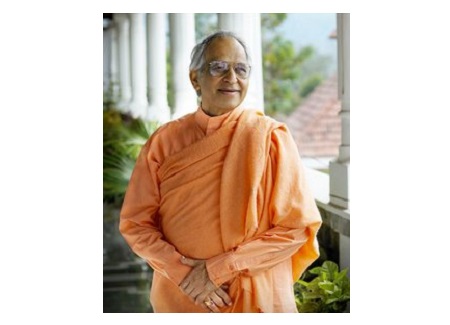
“Ways into Silence” by Swami Veda Bharati
Ways into Silence
by Swami Veda Bharati
 (This passage has been taken from the upcoming book titled Silence Volume II, Light Beyond Mind, published by Himalayan Yoga Publications Trust, which was released during the AHYMSIN 2019 Sangha Gathering at Swami Rama Sadhaka Grama, Rishikesh.)
(This passage has been taken from the upcoming book titled Silence Volume II, Light Beyond Mind, published by Himalayan Yoga Publications Trust, which was released during the AHYMSIN 2019 Sangha Gathering at Swami Rama Sadhaka Grama, Rishikesh.)
Bring your awareness only to the space that your body is occupying. This space is devālaya, temple of God. Be aware of being. No names, no forms, no conditions, no associations. Dwell by the self within the Self. Un-wrinkle your mind. Feel the flow and the touch of the breath in your nostrils. Breathe gently, slowly and smoothly. No jerk in your breathing, no sound in your breathing. Maintain the flow of the feel of the breath; together with the flow of the Divine name [mantra thought] in the mind. Observe how the breath, the mind and the name are flowing together as a single stream. No break in your breathing. No break in the thought of the name. Observe how the breath, the mind and the name are flowing together as a single stream. Your entire mind becomes an even flowing stream. [When you are ready] without breaking the feel of the flow of consciousness gently open your eyes. Maintain the flow even with your eyes open. Resolve to make the mind an even flowing stream many times in the day. Whatever you do repeatedly with your mind will become the mind’s habit and the mind will rediscover its original calm nature.
God bless you.
Those who are new and have not had previous experience of meditation, do the five-minute meditation that we teach beginners [as above]. Whenever you do not have time [to sit for a long meditation] then do this five-minute, three-minute, two-minute meditation repeatedly [throughout the day]. It is easier and quite often more effective than the 30-minute or three-hour meditation. I still see many people trying to practice, putting in too much effort. The forehead should be completely relaxed. All the limbs should be totally relaxed.
Always bring your attention only to the place where you are sitting. If you have a Guru invoke the Guru’s presence in that asana, in that seat, so it is not you who is meditating. It is the Guru who is meditating in you, in your body.
Now on the different paths into silence and on different depths of silence, I explained that the use of a mantra is to replace random thoughts and then gradually even the mantra is silenced. But when the verbal thoughts are reduced or disappear, visual imaginations begin to arise in the mind during meditation. Those visual imaginations again begin to produce other thoughts. These verbal thoughts are not from intellectual verbal processes. They are from emotional associations. They are even more illogical than the illogical chains of verbal thoughts. They are more difficult to calm down. First of all they are more difficult to detect and observe because it is the nature of our random emotions that there is no logic to them. Even the positive emotions cannot be arrived at by a logical process. The logical processes can be helpful in evoking positive emotions but they are not the real sources of the positive emotions, such as cultivating thoughts of friendship, love, universality and so on.
A meditation guide needs to know these processes that go on in the minds of the students and disciples. There are certain very subtle signs by which a meditation guide knows where a student’s meditation is going at any given time. The random visual imaginings are replaced by prescribed visual concentrations. Just as random verbal thoughts are replaced with the prescribed verbal mantra so also the random emotional associations and related visual imaginations are replaced by visual mantras.
The science of visual mantras is even more complex than the science of verbal mantras. For example, concentrating on a flame or drawing a little dot on the wall and concentrating on that is a visual mantra. These are beginner-level practices. We do not teach those practices although they are known. The second stage may come when you have been observing, for example, a flame. Then you close the eyes and maintain the flame in your mind and see how long you can maintain that flame. The third stage is when you do not need to look at the flame or at the dot. You can produce the flame from memory whenever you wish.
In our Tradition, we caution that these are externalized practices. Our purpose is to go into the deep internal faculties and energies. Although I am describing these to you I would not want you to get lost in practicing each of these. Keep to the essentials. Our Tradition has given us certain shortcuts. For example, the five-minute meditation we just did is a shortcut.



